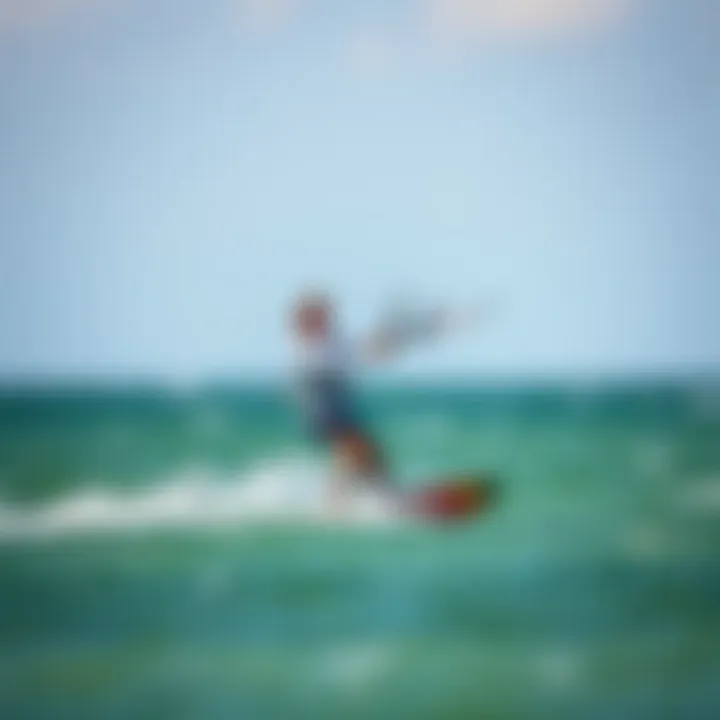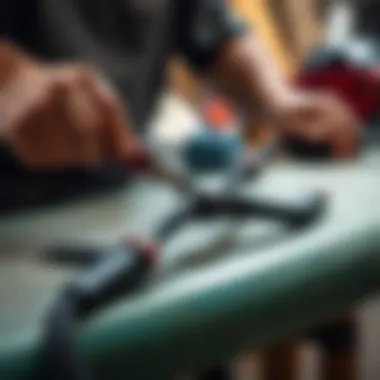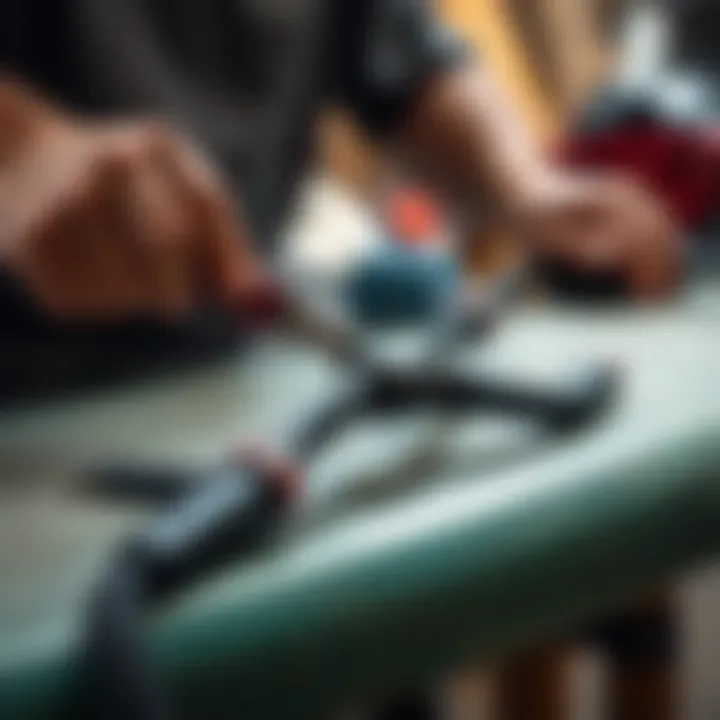In-Depth Look at the Cabrinha Control Bar Design


Intro
Understanding the Cabrinha control bar goes beyond merely grasping its basic features. It’s about immersing oneself in the soul of kiteboarding equipment. The control bar is a vital link between a kiteboarder and the kite itself. Throughout this guide, we will untangle its functionality, explore the design nuances, and uncover the safety features that are pivotal for both beginners and seasoned riders.
The Cabrinha control bar has earned a reputation not just for its performance but for its adaptability. As kiteboarding continues to evolve, so does the gear that propels the sport forward. This exploration will arm you with insights—whether you’re just starting or aiming to enhance your skills. Let’s dive into the details and see what makes this control bar an indispensable part of your kiteboarding journey.
Gear Selection
Choosing the right gear is the foundation for a memorable kiteboarding experience. The Cabrinha control bar, coupled with the right kite and board, ensures that you can ride safely and efficiently.
Types of Kites
When you think of kiteboarding, kites come to mind first. Cabrinha offers a range of kites that cater to different styles and conditions. From the versatile Switchblade to the nimble Drifter, understanding the characteristics of each kite helps in making the right choice for your riding style.
- Switchblade: Known for its power and consistency, suitable for most conditions.
- Drifter: Ideal for surfers, this kite excels in wave riding.
- Velocity: Targeted towards racers, it offers speed and performance.
Choosing the Right Board
Selecting a board to pair with your Cabrinha control bar can greatly impact your performance on the water. The choice of board depends on your skill level and the type of riding.
- Freestyle Boards: Best for those looking to perform jumps and tricks.
- All-around Boards: Perfect for riders who want flexibility for different conditions.
- Surf Boards: Ideal if you’re into riding waves.
Feel free to check out Cabrinha’s official site for more information on their kite and board offerings.
Skill Development
With the right gear in place, honing your skills becomes the next step. The Cabrinha control bar deserves attention in this area, as your proficiency with it can enhance your overall performance.
Essential Techniques
Familiarity with the control bar can significantly boost your ability to navigate the water effectively and safely. Here are some techniques to consider:
- Depower Handling: Learn to use the depower strap to adjust the power of the kite based on wind conditions. It’s crucial during gusty days.
- Bar Positioning: Keep your hands consistent and close to the center for a more reactive response from the kite.
Progression Tips
For those looking to elevate their kiteboarding game, consider these pointers as part of your practice regimen:
- Consistent Practice: Regularly hit the water to stay sharp.
- Observe Others: Watching skilled riders can provide insights into techniques you might want to emulate.
- Seek Feedback: Involvement in a community, perhaps through forums like Reddit, can lead to valuable tips from experienced riders.
"The way you handle your gear can make the difference between a thrilling day on the water and a day of frustration."
In summary, mastering the Cabrinha control bar is as much about understanding your gear as it is about developing your skills as a kiteboarder. We’ll continue to explore more aspects of this essential tool and its role in optimizing your kiteboarding experience.
Intro to the Cabrinha Control Bar
The Cabrinha Control Bar is not merely a piece of equipment; it is pivotal for any kiteboarding experience. For both newcomers and seasoned riders, understanding its role can make the difference between a thrilling day on the water and one spent wrestling with equipment.
A control bar serves as the primary point of interaction between the rider and the kite. Through its design, it enables nuanced steering and control, allowing kiteboarders to express their style and skill on the water. When we discuss the Cabrinha Control Bar, we're addressing an integral component designed with precision and craftsmanship that resonates deeply within the kiteboarding community.
Historical Context
The roots of the Cabrinha Control Bar can be traced back to the early evolution of kiteboarding itself. Cabrinha, founded by the kiteboarding pioneer Pete Cabrinha, was among the first companies to take kite technology to new heights. The first control bars were rudimentary, often causing confusion and frustrating experiences for riders. Over time, through relentless innovation, the design transformed. Cabrinha's presence in the market has continually pushed boundaries, introducing enhancements in materials and functionality that modern kiteboarders have come to rely on.
Through decades of testing and feedback from countless riders, the design of the Cabrinha Control Bar has evolved. Each iteration integrates lessons learned from the past, making it a significant player in the ongoing narrative of kiteboarding gear. What began as a simple bar with lines has morphed into a sophisticated instrument tailored for safety and performance.
Purpose and Functionality
At its core, the Cabrinha Control Bar is engineered to provide exceptional control and responsiveness. When you grip this bar, you are not just holding on to a piece of equipment; you are tapping into the very essence of kiteboarding.
The primary functions of the control bar include:
- Steering the Kite: By pulling or pushing on the bar, riders can change the kite’s angle and direction, which translates to how the kite behaves in the air.
- Adjusting Power: The bar allows solo control over power levels. Whether eager for a surge of speed or seeking to trim back, it reacts promptly to the rider’s adjustments.
- Safety Functionality: Many modern control bars, including the Cabrinha, incorporate a quick release system that instantly depowers the kite in emergencies, enhancing overall safety on the water.
Using the Cabrinha Control Bar is akin to communicating directly with your kite. Every tug, pull, and release sends signals that determine not only the kite's movements but also the rider's trajectory. In this way, it amplifies the rider’s intent, making the experience more intuitive and in tune.


Understanding the historical context and the inherent purpose of the Cabrinha Control Bar is essential for using this equipment to its fullest potential. As kiteboarding continues to evolve, so too does the role and functionalities of the Cabrinha Control Bar, ensuring it remains at the forefront of this exhilarating sport.
"A kitebar is your voice in the sky; it expresses your intent and shapes your journey over water."
When diving into the technical aspects of the Cabrinha Control Bar, we recognize that knowing how it operates is just as important as understanding its history. This critical understanding plays a vital role in optimizing the riding experience, leading us to explore its design features next.
Design Features of the Cabrinha Control Bar
The design features of the Cabrinha control bar are crucial for ensuring that kiteboarders experience both performance and safety. The thoughtful craftsmanship that goes into each component can significantly influence how kites respond to steering inputs, ensuring that riders maintain control even in challenging conditions. Understanding the intricate design allows enthusiasts to optimize their equipment for a better riding experience.
Materials Used in Construction
The Cabrinha control bar utilizes high-quality materials specifically selected for their durability and performance. From the lines to the bar itself, each element is crafted to withstand the rigors of diverse environments.
- Line Safety: The lines, usually made from Dyneema or similarly strong fibers, offer low stretch and high tensile strength. This characteristic not only ensures better responsiveness but also enhances safety by minimizing the risk of line snap during intense riding.
- Bar Composition: The bar typically employs lightweight composites or aluminum, striking a balance between weight and strength. This choice reduces overall fatigue for riders during extended sessions on the water.
- Coatings: Many components come with specialized coatings to resist wear and tear from UV rays and saltwater exposure, extending the bar's lifespan and performance reliability.
By selecting high-performance materials, Cabrinha ensures their control bar can handle the demands of kiteboarding without compromising functionality.
Ergonomic Considerations
Ergonomics play a pivotal role in the design of the Cabrinha control bar, creating a seamless interaction between rider and kite.
- Grip Design: The grip is often crafted with textured rubber or foam polymers, allowing riders to maintain a firm hold, even in wet conditions. This ensures that fatigue is kept at bay, enabling longer and more enjoyable sessions.
- Shape and Width: A well-contoured bar shape can promote intuitive handling. Cabrinha often designs the bar width to facilitate a natural position of the hands, minimizing strain during aggressive maneuvers.
- Wrist Positioning: The specific curvature in the bar's design helps align the wrist correctly. A well-positioned wrist minimizes chances of strain or injury, which is especially crucial for newer riders still mastering their craft.
The careful attention to ergonomics in the Cabrinha control bar reflects a commitment to rider comfort, enhancing overall performance.
Dimensions and Adjustability
Having the right dimensions and adjustability options significantly impacts the utility of the Cabrinha control bar.
- Adjustable Width: Many models feature an adjustable bar width, which enables riders to customize their setup according to personal preference or specific riding styles. This customization allows for optimal balance and control, depending on the conditions.
- Line Length Options: The control bar generally offers varying line lengths, tailoring the kite's responsiveness to different setups. For example, shorter lines usually provide a more direct feel, while longer lines can enhance lift and hangtime.
- Tuning Mechanisms: Cabrinha’s attention to detail often extends to tuning systems that let users fine-tune bridle settings, aligning performance characteristics to the rider’s skill level.
In essence, the dimensions and adjustability of the Cabrinha control bar not only cater to individual preferences but also enhance overall performance, helping kiteboarders to maximize their experience on the water.
Performance Aspects
When it comes to kiteboarding, every detail counts, especially how the control bar interacts with the kite. This section dives into performance aspects, which are vital for any rider looking to enhance their experience on the water. Performance can be broken down into two critical components: how responsive a kite is to input and the overall stability and control the rider can expect. Let's take a closer look.
Influence on Kite Responsiveness
The responsiveness of a kite is largely defined by how it reacts to the inputs given through the control bar. This aspect is crucial because it directly affects how a rider maneuvers. For instance, an average kite might respond sluggishly, which can be an issue when swift reflexes are required during dynamic conditions. On the other hand, a responsive kite allows for quick turns and rapid adjustments, giving the rider an edge in performance.
Factors that govern how responsive a kite is include:
- Line Length: Longer lines can sometimes mean more time lag between input and response. Shorter lines can allow for quicker adjustments.
- Bar Pressure: The amount of pressure a rider feels can adjust while steering the kite. A well-tuned bar provides feedback about the kite's positioning, so adjustments can be made swiftly.
- Bridle Configuration: Different setups can drastically alter responsiveness. The choice of bridle points can either enhance or restrict the movement of the kite.
Ultimately, a control bar that facilitates better responsiveness translates into a richer, more engaging riding experience. Riders should look for features in the Cabrinha Control Bar that align with their personal style and riding conditions.
Stability and Control
Stability is another essential performance aspect that cannot be overlooked. A stable kite enhances a rider's confidence, especially in changing wind conditions. When a kite is stable, it flies more predictably, which is particularly vital for those just starting or in gusty winds.
The stability provided by the Cabrinha control bar can be attributed to various design elements:
- Center of Balance: The design aims to position the center of weight in a way that minimizes unwanted movements. This means that the kite behaves predictably, regardless of external factors like wind gusts.
- Adjustable Trim: By allowing riders to fine-tune the seek of their bar, they can combat external forces that may destabilize their kite. This ensures a smoother ride, which is particularly valuable during tricks or in turbulent conditions.
- Material Tension: The materials used in constructing the control bar help maintain shape and tension on the lines, ensuring that the kite remains where the rider intends it to be.
A stable kite not only enhances the ride but also aids in the overall enjoyment of the sport, making it suitable for both beginners and seasoned kiteboarders.
Safety Features of the Cabrinha Control Bar
Safety is a cornerstone in any sport, and kiteboarding is no exception. The Cabrinha Control Bar is equipped with features that prioritize rider safety, making it an essential consideration for any kiteboarding enthusiast. Understanding these safety mechanisms is critical not just for new riders, but also for seasoned professionals looking to refine their skills and ensure their well-being on the water. The right safety features can mean the difference between a thrilling experience and a dangerous one.
Quick Release Mechanisms
The quick release mechanism is one of the most crucial safety features on the Cabrinha Control Bar. This system allows riders to detach themselves from the kite swiftly, which is vital during emergencies. Imagine you’re soaring through the air, and something goes awry—maybe a gust of wind throws you off balance, or your kite tangles unexpectedly. In situations like these, a reliable quick release mechanism can save you from a potential hazard.
For instance, the Cabrinha Control Bar employs a simple yet effective release system that can be activated with a single pull. This feature is designed to minimize the time it takes for a rider to disconnect from the kite. Users have reported that, during critical moments, this mechanism works smoothly, providing immediate relief from an uncontrollable situation.


Moreover, this system is thoughtfully designed to prevent accidental releases. Riders can adjust their grip according to their comfort, allowing them to enjoy their ride without the nagging fear of an untimely disconnection. The learning curve is manageable, even for those relatively new to the kiteboarding sports—it’s intuitive, ensuring that riders can focus on their performance without second-guessing their gear.
"The safety of riders is paramount. The quick release mechanism on the Cabrinha Control Bar is a testament to that commitment."
Safety Systems Overview
Diving deeper into safety systems, the Cabrinha Control Bar incorporates multiple layers of safety features that work in tandem to protect riders during their adventures. Among these features is the safety leash, which connects the rider to the kite and provides a backup safety option if the quick release is activated. This system is designed so that if a rider has to release the kite, they are not completely left without control. The safety leash allows for a minimal drift in the kite's position, keeping it manageable, and giving the rider more time to compose themselves.
Furthermore, the bar features visual indicators that help riders ensure that all safety systems are functional and correctly set up before embarking on their session. Riders can conduct a quick inspection—a habit that can ultimately lead to safer practices in kiteboarding. This simple act of checking can seem tedious, but it pays off, especially when conditions are unpredictable.
In terms of user feedback, riders have praised the Cabrinha Control Bar not just for its immediate safety features but also for its long-term reliability. Riders have commented that over several seasons of use, the safety mechanisms maintain their effectiveness, which speaks volumes about the brand’s focus on durability and trustworthiness.
In essence, the safety features of the Cabrinha Control Bar are not mere add-ons—they form the backbone of a responsible and engaging kiteboarding experience. The combination of quick release mechanisms, safety leashes, and user-friendly inspection tools showcases Cabrinha's commitment to protecting riders, reinforcing the notion that safety and performance can indeed coexist in action sports.
By choosing equipment that takes safety into account, kiteboarders can fully concentrate on enjoying the ride rather than worrying about unseen hazards. Therefore, the importance of these safety features cannot be overstated—they are fundamental to a positive and secure kiteboarding experience.
User Experience
User experience with the Cabrinha control bar is pivotal, as it encapsulates how riders interact with this essential tool. This element is more than just the feel of the grips; it encompasses everything from comfort during extended sessions to the responsiveness of the bar under stress. A positive user experience can significantly enhance one's confidence and control while kiteboarding, leading to more enjoyable and safe rides.
When examining user experience, we must consider several factors:
- Comfort: The design of the grips and overall weight must fit comfortably in the hand, as this straight away affects how long a rider can comfortably operate the bar. Riders often seek feedback on whether the grip reduces fatigue over long periods.
- Responsiveness: This refers directly to how quickly and accurately a rider can react to their changing environment. Riders expect the control bar to translate their intentions into kite maneuvers without unnecessary lag or inaccuracies.
- Safety Features: Integrating safety into user experience means that riders not only have control but also peace of mind during their session. The presence of quick-release mechanisms, for example, influences riders' willingness to push their limits while kiteboarding.
Good user experience can make a world of difference. Riders who feel comfortable and safe will naturally be more adept at exploring new techniques and maneuvers.
Feedback from Riders
Gathering feedback from riders forms a solid foundation for understanding the Cabrinha control bar's effectiveness. Many users recount their experiences, noting how the control bar influences their performance.
From various forums and social media platforms, here’s what riders often highlight:
- Ease of Use: Many appreciate the straightforward setup and adjustments, which allows them to quickly get on the water without a lengthy pre-session routine.
- Comfort Level: Numerous riders mention the comfortable grip design that fits well in their hands. They note that this becomes especially important during longer sessions where fatigue could become a factor.
- Control and Precision: Riders underscore that the bar allows for precise input, making tricks easier to execute. This precision is particularly appreciated by those transitioning from beginner to intermediate stages.
Feedback varies, of course, but the overall sentiment remains largely positive, underlining the control bar's significant role in enhancing the kiteboarding experience.
Comparative Analysis with Other Brands
When it comes to user experience, it is crucial to position the Cabrinha control bar against offerings from other brands. Many kiteboarders often engage in discussions comparing various control bars in terms of feel and functionality.
Here are key points drawn from these discussions:
- Build Quality: Riders frequently highlight Cabrinha's sturdy construction compared to brands like Duotone or Naish. Although Duotone has their niche, many Cabrinha users find their gear more resilient in rough conditions.
- Ergonomics: While some competitors focus heavily on features, Cabrinha often prioritizes user comfort, making their bars easier to handle over long runs.
- Price Point: While Cabrinha control bars are not the cheapest on the market, riders typically see the value in the materials and design, often mentioned in contrast to more budget-centered options from other brands.
Ultimately, user experience varies widely among different brands. A rider's personal preference shapes their opinion, making choices subjective. However, Cabrinha consistently emerges as a front runner in areas related to comfort, build quality, and overall experience, making it a preferred choice among seasoned kiteboarders.
"The control bar feels like an extension of my body. When I ride with Cabrinha, it’s simple, responsive, and reliable. That's all I want." - A frequent rider's reflection.
Maintenance and Care
Caring for your Cabrinha control bar is not just about prolonging its life; it's essential for ensuring optimal performance and safety on the water. This section underscores the importance of proper maintenance and identifies key practices to keep your equipment in top shape. A well-maintained control bar can enhance your kiteboarding experience, minimizes risks, and can save you money in the long run by avoiding premature replacements due to preventable wear.
Regular Inspection Practices
To keep your gear ready for action, regular inspections are crucial. Here are some practices to consider:
- Visual Checks: Look over your control bar frequently for any signs of wear or damage. Pay attention to the lines, the bar itself, and any connectors. If you spot frays or tears, it’s time to assess whether a repair or replacement is necessary.
- Functionality Tests: Check the quick release system regularly. It should engage and disengage smoothly without excessive force. Err on the side of caution—if it feels sticky or operates inconsistently, dig deeper or consult a professional.
- Line Length Evaluation: Ensure that both front and back lines are of equal length. This is vital for kite control and stability. Uneven lines can cause uneven pull and might lead to complications while riding.
Cleaning Protocols for Longevity
Keeping your Cabrinha control bar clean is simple but often overlooked. Here’s how you can maintain it effectively:
- Fresh Water Rinse: After kite sessions, particularly in saltwater, rinse your bar with fresh water. Salt can corrode materials over time, so a quick rinse can prevent build-up and long-term damage.
- Gentle Cleaning Solution: For a more thorough clean, use a mild soap solution to wipe down the surfaces. Avoid harsh chemicals or abrasive tools which could scratch or damage.
- Dry Thoroughly: Let your control bar air dry completely before storing it. Moisture can promote mold and rust, particularly in metal parts.
"Regular maintenance is the lifeblood of your kiteboarding gear. Invest a little time now for a smoother ride later."
Customization Options


Customization options play a remarkable role in optimizing your kiteboarding experience with the Cabrinha control bar. With personalized adjustments, riders can fine-tune their setups to meet individual preferences and specific riding conditions, which ultimately enhances performance, comfort, and safety.
Adjusting Line Length and Settings
When it comes to adjusting line length and settings, every kiteboarder knows that one size doesn't fit all. The Cabrinha control bar allows for various adjustments in line length, catering to different riding styles and environmental factors. Depending on whether you are riding in flat water or choppy waves, you might want different line lengths to maximize control and efficiency.
- Shorter lines can provide more direct feedback from the kite, leading to quicker responsiveness—a commendable trait when navigating tricky conditions or executing advanced maneuvers.
- Longer lines, on the other hand, enhance the kite’s wind range and allow for smoother glides, which can be beneficial for those who enjoy cruising over waves or need additional lift for jumping.
It's wise to experiment with different lengths based on your skill level and riding preferences. Adjusting the line settings can also help in managing the amount of power you need during various maneuvers, ensuring your experience is both thrilling and safe. In this regard, riders looking for precision and control should familiarize themselves with how each adjustment makes them feel in action.
Accessory Compatibility
The Cabrinha control bar is designed with versatility in mind, accommodating various accessories that can enhance performance. From quick release systems to different types of safety handles, compatibility is key.
A few noteworthy accessories include:
- Foam floats: These attachments help keep the lines afloat, preventing snags and tangles when your focus is on flying high above the water.
- Kite hook: This can offer additional connection options for those who need an extra tether when going out into the surf.
- Camera mounts: For the thrill-seekers looking to capture their adrenaline-fueled moments, compatibility with camera mounts lets you record and share your adventures.
When selecting accessories, it's important to consider how they align with your specific needs and riding style. Some kiteboarders prefer minimal setups, valuing simplicity, while others seek enhanced performance through various tools and add-ons. Regardless of your choice, make sure that any accessory you get is specifically designed for compatibility with the Cabrinha control bar, ensuring both safety and optimal performance in your kiteboarding adventures. As technology evolves, keeping an eye out for upcoming accessories that claim to upgrade your experience can also be beneficial.
Always prioritize safety and performance over looks. Well-matched accessories can significantly influence how well you can control your kite in varying conditions.
By understanding these customization options, riders can set the stage for a significantly enhanced kiteboarding experience.
Emerging Innovations in Control Bar Technology
The kiteboarding industry is constantly evolving, and with that evolution comes the emergence of new technologies that aim to enhance the rider's experience. In particular, the advancements in control bar technology have significant implications on performance, safety, and user accessibility. Recent innovations not only improve the usability of the Cabrinha control bar but also integrate sophisticated features that can help riders gain an edge on the water.
Trends in Smart Technology Integration
As technology seeps into every aspect of our lives, it's no surprise that kiteboarding equipment is also embracing the trend. Smart technology integration within control bars is not merely a passing fad; it is a transformative shift towards enhancing overall performance, monitoring conditions, and maximizing safety.
One such innovation is the incorporation of wireless connectivity. Imagine a control bar that can sync with a smartphone application to provide real-time feedback on riding statistics, weather updates, or even GPS tracking. This allows riders to keep their focus on the water while equipping them with crucial information at a glance. Also, riders can set personal performance goals and track their progress over time.
Another aspect to consider is the integration of sensors in the control bar, which can monitor tension and movement. Such real-time data can help riders fine-tune their techniques, making adjustments as needed for an optimized experience.
In summary, smart technology integration is setting the stage for a more informed and enhanced riding experience:
- Real-time feedback: Riders can receive updates and adjust their techniques on the fly.
- Goal tracking: Technology allows for personalized targets that boost rider motivation.
- Condition monitoring: Stay updated on weather changes, ensuring safety on the water.
Future of Safety Features
Safety is paramount in any extreme sport, and kiteboarding is no exception. The future of safety features within control bars looks bright, with innovations taking center stage to offer additional layers of protection.
Next-gen safety mechanisms are being designed to be more intuitive and easy to use in emergencies. For instance, improvements in quick release systems are crucial, ensuring that a rider can disconnect from the kite swiftly. Future innovations may also see the introduction of automatic release features that activate upon severe pressure or unusual movements, which might signal a rider in distress.
Furthermore, the next wave of safety technology could include enhanced visibility solutions. Night riding has seen a sprinkle of interest, and incorporating LED lights or reflective materials in the control bar can make a significant difference in being seen in low-light conditions.
Moreover, riders may benefit from voice-activated commands or alerts that assist in the event of an accident. The idea is to have technology that not only aids in performance but also prioritizes rider safety without compromising ease of use.
End
The conclusion drawn from this comprehensive overview serves to highlight the Cabrinha control bar's critical characteristics and its impact on the kiteboarding experience. Understanding this key piece of equipment is essential for both novice and seasoned kiteboarders alike.
Recap of Key Insights
In reviewing all elements discussed, several crucial insights emerge:
- Functionality: The Cabrinha control bar isn't just about steering; it molds kite behavior, impacts responsiveness, and significantly enhances rider control.
- Safety Features: With built-in quick-release mechanisms and robust safety systems, it puts rider safety at the forefront, addressing concerns that every kiteboarder should prioritize.
- Customization: Options for personalizing the control bar ensure that each rider can fine-tune their setup, maximizing not only comfort but also performance on the water.
- Emerging Technology: The future of kiteboarding with the Cabrinha control bar suggests a trend toward smart technologies, promising even greater safety and performance enhancements.
These aspects combine to portray a piece of equipment essential to navigating the conditions, challenging one's limits, and ultimately enjoying the ride.
The Cabrinha Control Bar's Role in Kiteboarding
The role of the Cabrinha control bar transcends merely being an accessory; it is the bridge between the rider and the kite. This relationship defines not just performance but also the overall experience of kiteboarding. The control bar influences how a kite reacts during maneuvers, particularly during sudden wind changes or when confronted with waves. A finely tuned control bar can dramatically enhance a rider's ability to harness the power of the wind, leading to improved maneuverability, speed, and control.
Ultimately, the Cabrinha control bar embodies a blend of safety, design, performance, and customizability that caters to diverse riding styles and skill levels. By investing time to understand and effectively utilize this tool, riders can unlock their potential and safely explore the thrills of kiteboarding. As innovation continues to drive improvements, the importance of the control bar will only deepen, making it a focal point of continued growth in the sport.
"In kiteboarding, control is everything; the Cabrinha control bar offers not just control, but also a pathway to mastery."
Citations for further reading:















